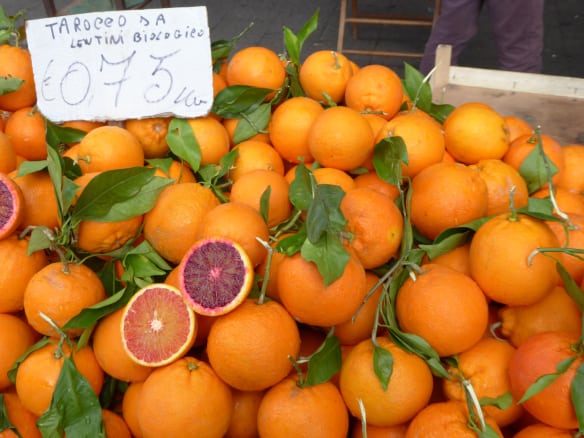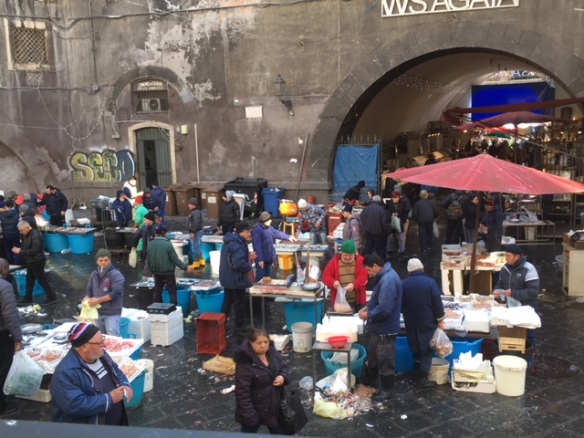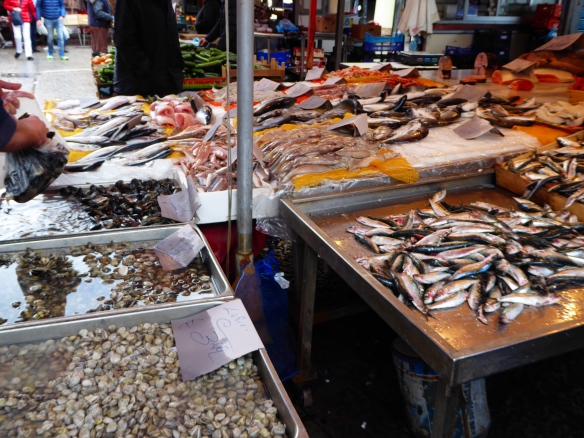Sicily markets are famous for its food, fresh and brimming with exquisite tastes, whether it be fruit, vegetables, meats, seafood or home-made pasta. The smallest village has at least a weekly market, while the bigger cities can have more than one market open 6 days a week, and most of these markets have been held at the same market stalls, often by the same families, for generations.
Whenever possible during our three week stay in Sicily, we shopped at the local market and cooked our dinners with the freshest foods available. The concept of farm-to-table may be trendy in 21st century America, but it’s been a way of life in Sicily for centuries.
The Best of Sicily Markets

Blood oranges on display in a Siricusa market in Sicily. (Sicily Markets)
Catania
Another great choice of Sicily markets is Catania. For about 3 square blocks to the right is a maze of crowded medieval streets and alleys thronged by covered stalls offering seafood, meats, fruits, vegetables, and a melange of dry goods and even household wares.

Catania, on the east coast of Sicily, is famous for its seafood. Thus it’s no surprise that its largest market, La Pescheria, revolves around seafood. A few steps from the city’s duomo (cathedral), La Pescheria is open six days a week and is crowded from early morning until mid-afternoon.
While the focus is on seafood, the hundreds of stalls offer an extensive range of fruits and vegetables and meats from the local favorite, rabbit, to pork, beef and chicken — and all the by products one can imagine coming from them.

Swordfish, or la spada, is plentiful as well as a favorite local fish. This baby was nearly 5 feet long.

Swordfish tails andblades decorate the back wall of one seafood stand.

Plucked chickens and skinned carcasses are offered whole at the meat stalls, as well as every cut and body part of four-footed animals one can imagine: pig feet and heads, tripe, sausages, whole rabbits, steaks and chops are all at hand.

A small sampling of the fruits and vegetables found at Sicily markets.

Part of one day’s haul at the market. The oranges were particularly delicious. We ate 1-2 each a day while in Sicily.
Ortigia, Siricusa Market
Ortigia, a small island now part of modern Siricusa, was one of the early Greek colonies dating to the 5th century B.C. Daily markets have been held in roughly the same location for hundreds of years. The Ortigia market had the usual offerings of fish, meats, fruits, vegetables, dried products and general goods, but the following displays caught my eye.

Sun-dried tomatoes, a must in every Sicilian kitchen! Here it was offered up by the bucketful. (Sicily markets)

Artichokes, a personal favorite! (Actually I was hard pressed to find anything that wasn’t a favorite!)

Bacalo (Salted Cod) in the Sicily markets
Bacala, dried, salted cod, is sold in all the Sicily markets as well as in most Mediterranean countries — also found on most seafood menus.

Spices in the Sicily markets
Fresh and dried herbs and spices are sold by the gram.

Along with fresh and dried pasta, dried nuts and fruits were for sale at most markets.

Luscious fresh vegetable soups are the fare in restaurants near Ortigia’s market. We asked for a vegetable soup at the Cafe Archimede and were told, a bit hesitantly, it would take about “20-30 minutes.” About 35 minutes later we were served this wonderful and obviously freshly prepared soup. Delicious!

Sampler platters like this or equally good (and massive sandwiches) are what draws daily crowds to the Borderi gli Artisti deli on the edge of Ortigia’s market. The huge molded, slightly browned cheese at the right is sheep’s milk ricotta, made fresh that morning, which was absolutely heavenly. Prosciutto, other cheeses, sausage, fennel salad, and oranges with chopped olives and honey rounded off this luncheon feast.

Locals and tourists daily line up outside the deli at lunchtime. Luckily our driver/guide Alessio Patane of Sicily Grand Tour knows the owner and was able to reserve us a table inside to enjoy our feast!
Giudecca
Sicily’s city neighborhoods abound with small markets, from the one-room mini-mart to roadside fruit and vegetable stands. One can find them in the least expected places. The Giudecca, or old Jewish Quarter in Ortigia, originated most likely during the Roman era of Siricusa although Jews had been present during the Greeks’ earlier reign.
The community was large, comprising by some accounts almost a third of the large Siricusa population. The ruins of an ancient mikveh, or ritual bath, is thought to be one of if not the oldest mikveh in Europe. We wandered the ancient streets, admiring the stone houses, many now renovated into trendy apartments or boutique hotels, but many small colorful spots caught my eye.

Sicily markets
One dwelling in the Sicily markets was Giudecca’s own outdoor mini-mart, with fresh veggies and fruits for sale. I heard soft music coming from inside the house so I suppose you just called out when you were ready to purchase. Either that or leave some Euros in the red pot to the left!

Colorful pots and plants and a touch of paint make this dwelling appealing.

This doorway was my favorite in all of Giudecca. Not related to a market, just randomly placed items that made a fetching photo.
Palermo
Palermo was our last stop in Sicily and the last of our Sicily markets we explored. While for once, we didn’t stay in an apartment with a kitchen, we still shopped at the famous Ballaro Market in the historic section of the city. After all, we had to feed our daily addiction to Sicilian oranges!
While there were certainly a number of seafood stalls, the Ballaro didn’t come close to having the scope of seafood stalls and offerings of La Pescheria in Catania, but there were certainly a number of luscious fruits and vegetables to drool over.


Just a sampling of the fruits and vegetables on offer.

A colorful array of dried fruits, herbs and spices available from one vendor.

And, of course, being a port town, Palermo’s Ballero displayed many varieties of seafood for sale.
So long to Sicily markets, and on to Tuscany’s allures. It will be interesting to see if the street markets there can offer such a colorful and variable selection as Sicily’s! Be sure to check out our Italian page as well.
Other Articles You May Enjoy!
- Segesta and Ancient Ruins in Sicily, Italy
- Exploring Tuscan Cooking in the Heart of Italy
- Rome Italy: What to see in Rome
- 5 Things to Explore in Barcelona Spain
- Cruising the Mediterranean in an Eco-Friendly Way
- WBTW’s Italy section

Carol Barbier Rolnick grew up in Japan and Southeast Asia, traveling extensively as a child through Asia, the Mideast and Europe on family vacations. Travel has continued as a priority through raising kids and continuing into retirement, extending adventures through the Americas, southern Africa, Asia, and repeat trips throughout Europe. Carol and her husband, Michael spent four summers based in Utrecht, The Netherlands, which has become like a second home. They are (still) aiming towards Australia-New Zealand and Antarctica to round off their continental travels.








